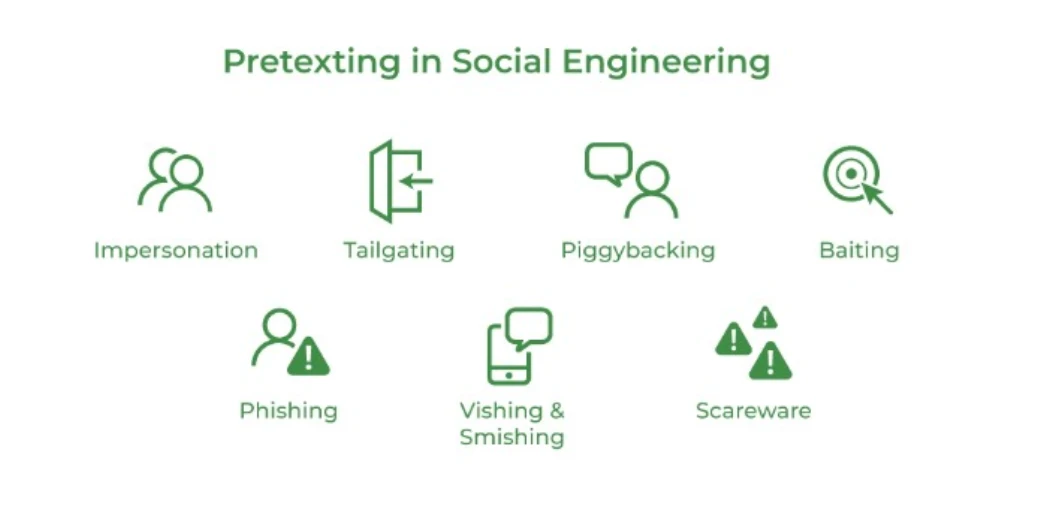What is Pretexting?
Pretexting is a form of social engineering where an attacker creates a fabricated scenario—or "pretext"—to deceive someone into sharing sensitive information or granting access to restricted systems. Unlike phishing, which often casts a wide net with generic emails or messages, pretexting is highly targeted and relies on building trust through a convincing backstory. It’s a psychological manipulation tactic that exploits human nature, making it one of the sneakiest and most effective tools in a cybercriminal’s arsenal. Whether it’s posing as a coworker, a customer service rep, or even a government official, pretexters thrive on their ability to blend in and seem legitimate.
At its core, pretexting hinges on storytelling. The attacker researches their target—often using publicly available data from social media, company websites, or even data breaches—to craft a believable narrative. For example, they might call an employee pretending to be an IT staff member, claiming they need login credentials to resolve a server issue. The story feels urgent, the details align, and the unsuspecting victim complies. This tailored approach sets pretexting apart from broader scams, as it leverages specific knowledge to bypass skepticism and security protocols.
So, how does pretexting differ from other cyber threats? While phishing typically involves mass emails with malicious links or attachments, pretexting often unfolds over personal interactions—phone calls, text messages, or even in-person encounters. It’s less about tech wizardry and more about human psychology. Pretexters don’t always need malware; they need your trust. That said, pretexting can still intersect with phishing—like when an attacker sends an email pretending to be your boss asking for a wire transfer. The lines blur, but the essence of pretexting is its reliance on a fabricated identity or situation.
The goals of pretexting vary but are almost always malicious. Attackers might seek financial data, login credentials, personal identification details, or even trade secrets. In some cases, it’s a stepping stone to larger attacks, like infiltrating a corporate network. Businesses and individuals alike are vulnerable, especially in an era where oversharing online makes it easier for attackers to gather the puzzle pieces they need to build their ruse.
Pretexting isn’t new—it’s been around long before the internet, think of con artists impersonating officials to gain trust. But today, with technology amplifying reach and resources, it’s a growing cybersecurity threat. Understanding what pretexting is and how it exploits trust is the first step to staying one step ahead of these digital deceivers.
Understanding Pretexting in Cybersecurity
Pretexting in cybersecurity is more than just a clever lie—it’s a deliberate and sophisticated attack vector that exploits human vulnerabilities rather than technical flaws. At its essence, pretexting involves an attacker creating a false persona or scenario to trick a target into divulging confidential information or performing actions that compromise security. In the realm of cybersecurity, this tactic stands out because it doesn’t rely on hacking code or breaching firewalls; it hacks the mind. By impersonating someone trustworthy—like a colleague, a vendor, or even a law enforcement officer—pretexters manipulate their victims into lowering their defenses, making it a potent threat in an increasingly connected world.
Definition of Pretexting
So, what exactly is pretexting? It’s a social engineering technique where the attacker constructs a believable pretext to justify their request for information or access. This could be as simple as a phone call from someone posing as a bank representative asking for your account details to “verify a transaction,” or as elaborate as a multi-step scheme involving fake emails, forged documents, and follow-up calls. The key is credibility: pretexters often arm themselves with just enough personal or contextual details—gleaned from social media, leaked data, or reconnaissance—to make their story hold water. In cybersecurity, this makes pretexting a gateway to data breaches, identity theft, and financial fraud.
How Pretexting Differs from Phishing
While pretexting and phishing both fall under the social engineering umbrella, they’re not twins. Phishing casts a wide, often automated net—think spam emails with malicious links sent to thousands. Pretexting, by contrast, is a sniper shot: targeted, personal, and labor-intensive. A phisher might hope you click a fake login page; a pretexter might call you, claiming to be from HR, and ask for your payroll password under the guise of an audit. Phishing leans on volume; pretexting banks on precision and trust. Understanding this distinction is critical in cybersecurity, as defending against each requires different strategies.
Common Goals of Pretexting Attacks
What do pretexters want? Their endgame varies, but it’s always high-stakes. They might aim to steal login credentials to infiltrate a company’s network, extract sensitive customer data for resale on the dark web, or trick someone into authorizing a fraudulent payment. In some cases, pretexting is a stepping stone to bigger attacks, like ransomware deployment or espionage. Whatever the prize, the stakes in cybersecurity are enormous—lost data, reputational damage, and legal fallout are just the start. Recognizing pretexting’s role in this landscape is the first line of defense.
How to Identify Pretexting Attempts
Spotting a pretexting attempt can feel like trying to catch a chameleon—it blends in until it’s too late. In cybersecurity, where attackers rely on deception to bypass defenses, knowing how to identify these scams is crucial for protecting yourself and your organization. Pretexting thrives on trust, urgency, and just enough truth to seem plausible, but there are telltale signs you can learn to recognize. By staying vigilant and questioning the unexpected, you can turn the tables on these social engineering ploys before they escalate into full-blown breaches.
Red Flags to Watch For
Pretexters are masters of manipulation, but their tactics leave clues. One major red flag is unsolicited contact—whether it’s a call, email, or text—from someone claiming authority or familiarity. If the interaction feels off, trust your gut. Another warning sign is urgency: pretexters often pressure you to act quickly, saying things like “Your account’s been compromised” or “We need this now to avoid penalties.” Requests for sensitive information—like passwords, PINs, or financial details—should also raise alarms, especially if they bypass normal channels. Legitimate entities rarely ask for such data out of the blue.
Common Pretexting Scenarios
Understanding the scripts pretexters use can sharpen your defenses. A classic scenario is the “IT support” call, where someone claims they need your login credentials to fix a system issue. Another is the “vendor check-in,” where an attacker poses as a supplier asking for updated payment details. Then there’s the “authority figure” ploy—think fake IRS agents or police officers demanding personal data under threat of legal action. These scenarios often sound convincing because they’re tailored with details pulled from your online footprint, like your job title or recent transactions. Recognizing these patterns is key to sniffing out the scam.
Tools and Techniques to Verify Suspicious Requests
When in doubt, verify before you comply. If someone contacts you unexpectedly, don’t use the contact info they provide—look up the official number or email yourself and reach out directly. For example, if “HR” emails about a payroll update, check with your HR team through known channels. Two-factor authentication (2FA) can also thwart pretexters by adding a layer they can’t easily bypass. Training yourself to pause, question, and cross-check suspicious requests turns you into a human firewall against pretexting. In a cybersecurity landscape where human error is the weakest link, these simple habits can make all the difference.






